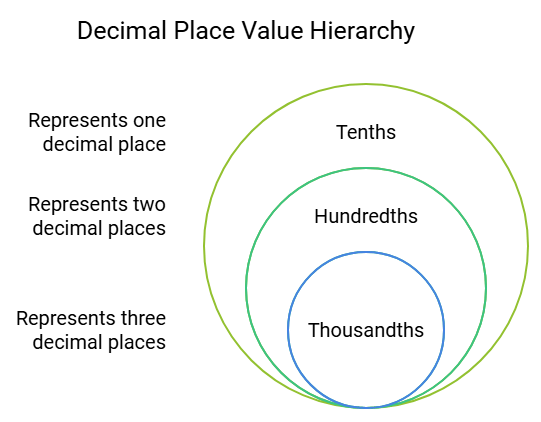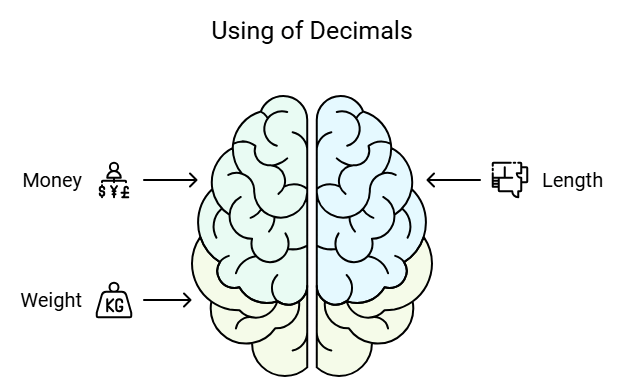Class 6 Exam > Class 6 Notes > Maths Olympiad Class 6 > NCERT Summary: Decimals
Decimals Summary Class 6 Maths Chapter 8

Decimals
- Fractions with denominator 10, 100, 1000, etc. (known as decimal fractions) can be written in a form using a decimal point.
- A decimal has two parts-whole number part and decimal part. These parts are separated by a dot (.). called the decimal point.
Tenths
- Decimal fractions with 10 as denominator.
- One-tenth = 1/10 = 0.1, read as point one.
- Two-tenths = 2/10 = 0.2, read as point two.
- Seven-tenths = 7/10 = 0.7, read as point seven.
Hundredth
- Decimal fractions with 100 as denominator
- One-hundredths = 1/100 = 0.01, read as point zero one.
- Two-hundredths = 2/100 = 0.02, read as point zero two.
- Seven-hundredths = 7/100 = 0.07, read as point zero seven.
Question for NCERT Summary: DecimalsTry yourself: What is the decimal representation of five-tenths?View Solution
Thousandths
- Decimal fractions with 1000 as denominator.
- One-thousandths = 1/1000 = 0.001 read as point zero zero one.
- Two-thousandths = 2/1000 = 0.002 read as point zero zero two.
- Seven-thousandths = 7/1000 = 0.007. read as point zero zero seven.

Fractions as Decimals
- Fractions can be converted into decimals by writing them in the form with denominators 10.100, 1000 and so on. For example, 5/10 = 0.5, 5/100 = 0.05.
Decimals as Fractions
- Decimals can be changed into fractions by taking away the decimal point and using 10, 100, etc., as the denominator, depending on how many digits are after the decimal point. For instance, 0.7 = 7/10 and 0.07 = 7/100.
- Every decimal can be expressed as a fraction.
Addition of Decimals
- Convert the given decimals into like decimals.
- Write the addends one under the other in column form, keeping the decimal points of all the addends in the same column and the digits of the same place in the same column.
- Add as in the case of whole numbers.
- In the sum, put the decimal point directly under decimal points in the addends.
Subtraction of Decimals
- Convert the given decimals into like decimals.
- Write the smaller number under the larger one in column form in such a way that the decimal points of both the numbers are in the same column and the digits of the same place lie in the same column.
- Subtract as we do in case of whole numbers.
- In the difference, put the decimal point directly under the decimal points of the given numbers.

Using Decimals
- Many daily life problems can be solved by converting different units of measurements such as money, length, weight, etc. in the decimal form.
Money
- 100 paise = ₹1
- 1 paise = ₹1/100 = ₹0.01
- 5 paise = ₹5/100 = ₹0.05
- 105 paise = ₹1 + 5 paise = ₹1.05
- 7 rupees 8 paise = ₹7 + ₹0·08 = ₹7.08
- 7 rupees 80 paise = ₹7 + ` 0·80 = ₹7.80
Length
- 10 mm = 1 cm
- 1 mm = 1/10 cm = 0.1 m
- 100 cm = 1 m
- 1 cm = 1/100 m = 0.01 m
- 1000 m = 1 km
- 1 m = 1/1000 = 0.001 km
Weight
- 1000 g = 1 kg
- 1 g = 1/1000 kg = 0.001 kg
- 25 g = 25/1000 kg = 0.025 kg
The document Decimals Summary Class 6 Maths Chapter 8 is a part of the Class 6 Course Maths Olympiad Class 6.
All you need of Class 6 at this link: Class 6
|
30 videos|120 docs|59 tests
|
FAQs on Decimals Summary Class 6 Maths Chapter 8
| 1. What is the definition of decimals? |  |
Ans. Decimals are a way of representing numbers that are not whole. They are numbers that have a decimal point, which separates the whole number part from the fractional part. For example, 3.5 is a decimal number.
| 2. How do you read decimals? |  |
Ans. To read decimals, start from the left and read the whole number part. Then say the decimal point followed by the individual digits of the fractional part. For example, 3.5 is read as "three point five".
| 3. How can decimals be compared? |  |
Ans. Decimals can be compared by looking at the value of their digits from left to right. Start comparing the whole number parts, then move to the tenths place, hundredths place, and so on. The greater the digit in the same place value, the greater the decimal number.
| 4. How can decimals be added or subtracted? |  |
Ans. To add or subtract decimals, align the decimal points and then perform the addition or subtraction operation as usual. Keep the decimal point in the same position in the result as it is in the given decimals.
| 5. How can decimals be multiplied or divided? |  |
Ans. To multiply decimals, ignore the decimal point and multiply the numbers as if they were whole numbers. Count the total number of decimal places in the given decimals and place the decimal point in the result after that many places.
To divide decimals, move the decimal point of the divisor to the right to make it a whole number. Then move the decimal point of the dividend the same number of places to the right. Perform the division as usual and place the decimal point in the quotient after the correct number of decimal places.
Related Searches






















